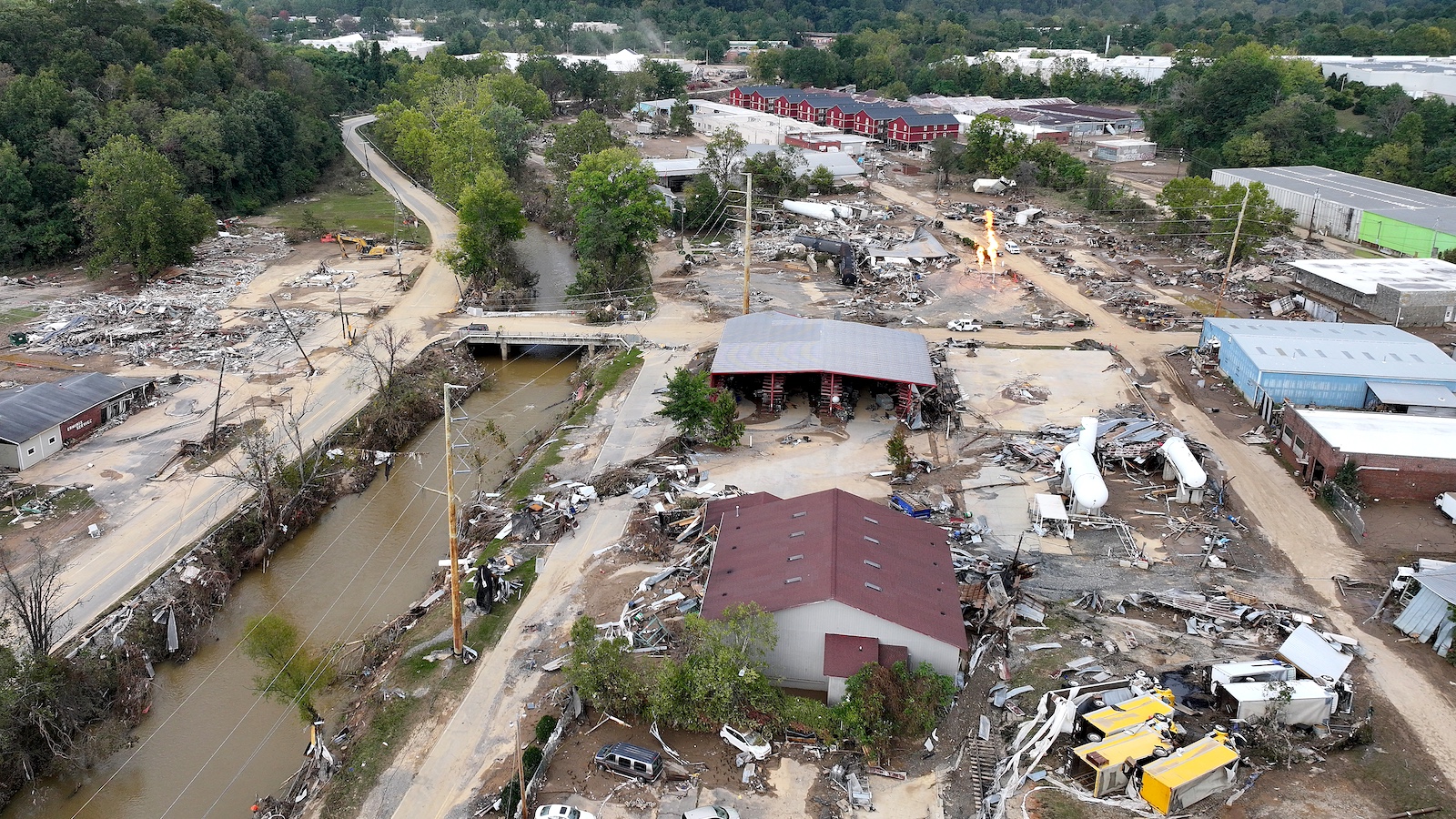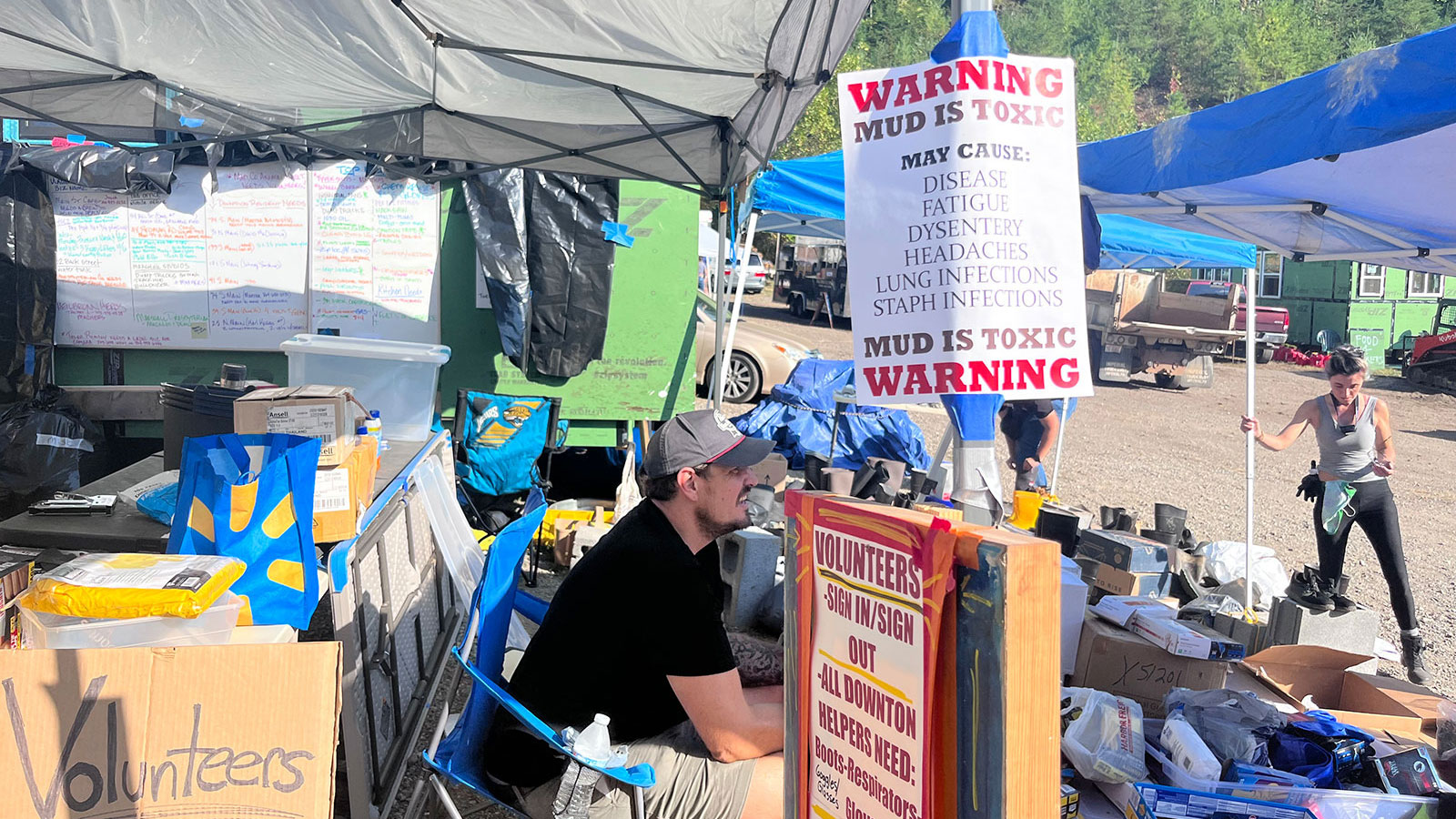Each day at 10 in the morning, more than a dozen people gather outside Gold’s Gym just south of downtown Asheville, North Carolina. After organizing themselves into groups — Spanish speakers in one, for example, and those with medical skills in another — they grab a couple of five-gallon buckets each and climb into trucks. Soon everyone rumbles off to spend the day performing an essential task: Flushing toilets.
Twenty days after Hurricane Helene brought torrential rain and deadly floods to western North Carolina, over 100,000 people still lack potable water. The crisis stretches beyond the city out to nearby mountain communities of Swannanoa and Black Mountain. Federal and state officials have been sending water, but supplies are limited, and as service is restored, locals are being told to boil anything that didn’t come out of a bottle. Even as hundreds of thousands of people continue digging out from the devastation wrought by the storm, the risk of disease is mounting.
That’s how it is with a natural disaster like Helene or Hurricane Milton, which walloped Florida last week: The immediate injuries and loss of life are inevitably followed by longer-term physical and mental impacts. People throughout western North Carolina, eastern Tennessee, and beyond are beginning to grapple with these secondary consequences, which are compounded by the lack of potable water and the polluted mess the flood washed over the landscape.
“Even after the water recedes, residents may underestimate the potential for contamination by unseen bacteria such as fecal coliform, heavy metals such as lead, and organic and inorganic contaminants such as pesticides,” Jennifer Horney, a disaster epidemiologist at the University of Delaware, warned in the wake of the hurricane.
The dozen or so toilet flushers who call themselves the “Flush Brigade” comprise one of several informal volunteer efforts that the people of Asheville rely upon to provide a basic level of sanitation. With the city’s water system knocked out by the floods and repairs expected to take weeks or more, residents have found themselves unable to take showers or even flush their toilets. Though municipal water is beginning to trickle back to the city, it’s highly chlorinated and filled with sediment.
Folks from the community nonprofit BeLoved Asheville started the Flush Brigade with help from a largely ad hoc band of water suppliers calling themselves Flush AVL. Everyone is working out of a brew pub downtown, and set to work visiting apartment complexes and mobile home parks almost immediately after the storm began. They’re at it all day, every day, and plan to stick around until the Asheville Water Resources Department is providing safe water again.
Earlier this week, they descended on Aston Park Tower, an 11-story public housing complex not far from downtown. Each carried a bucket sloshing with water as they crowded into elevators. Beyond helping folks with a task most people take for granted, the volunteers check on the well-being of the elderly, those with disabilities, and the homebound. Many of these Good Samaritans are nurses, and they expressed concern that the lack of sanitation could breed diseases like dysentery. For all the good an organization like The Flush Brigade is doing, the need far exceeds anyone’s capacity to meet it. The devastation is simply too great.
“I can’t go in and clean somebody’s room,” said one volunteer, a nurse who identified himself only as Norman. “I’m here to clean a wound. I can help take care of their person, but as far as where they’re living, their health is still at risk. But we’re not equipped to go in and mop somebody’s bathroom.”
Such limitations become clear in towns along the French Broad River, where residents complain about the foul, landfill-like odor that has come to permeate the air as soil saturated with flood waters containing an unknown combination of chemicals and sewage dries and turns to dust. It doesn’t help that residents feel they’re receiving confusing public health information.
Melissa Sue Gerrits/Getty Images
“We got these suits on because the mud is toxic,” said Oren Mcclure, who was wearing a Tyvek suit, goggles, and boots as he headed downtown with his friend Isaiah Embler to help clean up. “There’s like chemicals and human waste in it, and we don’t want that getting all over us.” Local officials are still testing soil samples to determine what might be in it, and official advice is still to treat the mud as hazardous.
Embler, who grew up here, never trusted the river to begin with, mostly because the town is downstream from the Woodfin sewage plant. “My whole life I’ve been told not to swim in the French Broad because of that reason,” he said. “This just ain’t helping it at all.”
He is right to be worried. The state Department of Environmental Quality has received more than 1,000 reports of potentially worrisome incidents in the wake of Helene: — oil drums leaking into ponds, homeowners pumping pooled sewage into creeks, wastewater treatment plans critically damaged by the flood. Weeks after the storm, public health departments across the state continue warning residents to test their wells and to boil or bleach their water. They also have also told people not to drink from rivers and creeks or use that water for cooking, or to even rinse their hands. State and local health departments are providing water testing kits to anyone who asks for one, and urge people to disinfect wells and test them for fecal matter and other contaminants. In some cases, health officials are making it abundantly clear the water is not safe.
“This water is not drinkable, even if you boil it,” the town of Black Mountain, outside of Asheville, says on its website. “It is NOT TO BE USED for anything but flushing toilets.”
Statewide, the official death toll from Helene stands at 125, with another 92 people missing. More than 2,000 households still don’t have power, and more than 600 roads remain closed. Against that backdrop, state and local officials are still engaged in search and recovery operations and scrambling to provide basic assistance. With all that’s happening, people in Asheville and beyond have said that the public health guidance they’ve received has been hard to parse.
“We haven’t gotten a whole lot of information from the top down, so we’re just kind of playing it by ear,” said Amos McGregor, who owns a record store in downtown Marshall, which sits 30 minutes north of Asheville, that was flooded.
When extreme weather brings flooding, the inundation courses into sewage plants, farms, and all manner of industrial operations, washing their contents over the landscape and into wells and water systems. That’s why public health officials in several counties throughout North Carolina and other states wracked by Helene are strongly urging residents not to touch the local waterways.
Flooded sewers always produce some degree of overflow. The sewage mixes into creeks, manholes, and wells, producing a dangerous soup of bacteria. Highly contagious illnesses like cholera, salmonella, and Norovirus can flourish in such conditions; all of these diseases can cause diarrhea, vomiting, and dehydration that can severely sicken and even kill the immunocompromised, elderly, and very young.

Mario Tama/Getty Images
Hurricanes and the flooding that comes with them don’t just stir up gastrointestinal diseases, they produce large quantities of dust, silt and mold that carry a different health risk. “People suffer at higher rates from some physical conditions, including upper respiratory infections, asthma exacerbations and allergies,” said Timothy William Collins, a disaster and health researcher at the University of Utah.
The medical and public health communities have long known that natural disasters intensified by climate change could continue to claim lives long after the immediate crisis has passed. They’ve seen this in Bangladesh, where flooding earlier this year overwhelmed sewage systems and sent the water-borne bacterial cholera into the water supply. In the Americas, the mosquito-borne illness dengue fever afflicted millions of people in 2022 and 2023, a spike health researchers attribute to flooding exacerbated by climate change.
Given all of this, Helene’s final tally is sure to rise, though if the past is any indication, even the official count may not reflect the storm’s true cost. When Hurricane Maria battered Puerto Rico in 2017, the government initially reported 64 deaths. A year later, an analysis that examined how many people would have died in the months after the storm if it hadn’t hit the archipelago found that the Category 4 cyclone actually killed more than 3,000 people.
Medical volunteers and epidemiologists on the ground in Asheville and the surrounding counties say it’s still too soon to tell what the most worrisome diseases might be, especially since Helene’s impact on communications has blunted data collection. A local doctor who identified herself only as Dr. Alexander has joined Elliott Patterson, a graduate student studying public health at University of North Carolina-Chapel Hill volunteering at field clinics around Asheville. They’ve seen a lot of people with irritating skin ailments and chronic respiratory conditions, like asthma, probably exacerbated by dust. That’s on top of things like blisters from yellowjacket stings; poison ivy contracted while slogging through mud, brush, and debris; and communicable diseases like COVID-19 and the flu that often make the rounds in shelters. But it’s hard to say for sure where things are trending, they said.
State epidemiologist Zach Moore acknowledged that the interruption of services at emergency rooms and health departments due to loss of power and internet, not to mention the disruption to their employees’ lives, is hindering data collection as well. “There are limitations there in terms of data for reportable conditions that we track on the individual case basis,” he said, though the state has been continuing to process lab results and receive physician reports.
At this point, only one thing is certain: The people of Asheville and the communities of the Blue Ridge Mountains will be grappling with the health impacts of this storm long after the floodwaters recede and the taps are running clear.
Source link
Katie Myers grist.org

